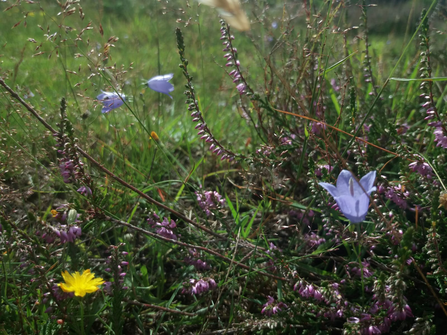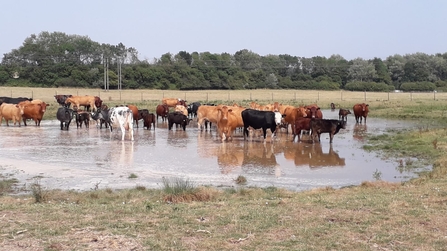Weekly wild news from our reserves, 21 August
Konik ponies grazing - Craig Hollis
We’ve had three new additions to our Hen Reedbeds site recently and we are so pleased that our four-legged friends have settled in well and made themselves quite at home. The new additions, two Welsh Section B’s and a New Forest pony, were spotted “horsing around” on Friday, mixing well with our long-serving Konik ponies.
Ponies are very useful in conservation management due to being selective grazers. They eat certain plants preferring grasses and other fine leaved species such as reeds, rushes and sedges whilst avoiding broad-leaved species. This selective grazing allows for a greater diversity of plants on our sites and as the ponies are allowed to roam freely, a mixture of habitats are created as some areas will be grazed more than others, with some not being grazed at all creating a mosaic of habitats for a variety of different species.
Konik ponies were originally introduced by Suffolk Wildlife Trust from the Biebrza Marshes in Poland to Redgrave and Lopham Fen in 1995 and have been a familiar feature on some of our sites since their introduction. This Polish breed of pony (konik being a Polish word meaning ‘small horse’) was chosen to graze our sites as they are hardy grazers, being able to withstand wet habitats and grazing well at edges of reed beds.
BBC Countryfile at Carlton Marshes
Carlton Marshes put on its best show for the Countryfile team and was looking stunning when the team visited to film for this coming Sunday's programme. Matt Gooch, our North East Suffolk Sites Manager, and volunteer Gavin Durrant, spent the day talking with presenter Margherita Taylor and filming Carlton’s wild side. We don’t want to give it all away, but we hear that they will be talking otters! Tune in this Sunday (23rd) at 7pm, BBC1, to see the team in action.
A bumper year for harebells
With its paper-like petals and fragile appearance, harebells could lead you to think that they are delicate “wall flowers”, however, they are tougher than they seem and they are incredibly resilient.
Growing in a habitat which demands the flowers to be tough and resilient to survive and grow, harebells can be found growing in dry open places such as bare hillsides and along our coastlines.
Our Knettishall Heath Ranger, Sam Norris, has reported that it has been a bumper year for harebells with more spotted this year than in the past eight years. This harebell was seen growing among ling heather at Knettishall Heath this week contrasting its purple petals nicely against clouds of pink heather.

Harebell in ling - Sam Norris
Small teasel
Cousin to the common teasel, small teasel is unsurprisingly smaller in size and has more rounded flower heads. It has long-stalked leaves and the globular flower heads present off-white flowers which sit upon a prickly stem.
Preferring to grow in damp open woodlands, it can often be spotted growing near rivers and streams and the best time to spot it is between August and September. Our North East Suffolk Reserves Warden, Jamie Smith spotted this lovely patch of small teasel providing a great source of nectar for pollinators at our Darsham Marshes reserve this week.
Bovine bathing
With the warm and dry summer continuing, our grazing herd of cattle enjoy cooling off in some of the scrapes and depressions out on the marshes at Trimley. The light 'poaching' of the muddy fringes made by the hooves of these inquisitive bovines is normally very beneficial for passage migrant birds such as green sandpiper, wood sandpiper and common sandpiper. The mini pools made by hoof prints create ideal conditions for aquatic and terrestrial life to thrive and provide an abundance of insects and other invertebrates for the sandpipers to eat. ‘My phone camera wasn’t quite up to the job of capturing the birds!’, said Andrew Excell, South East Suffolk Reserves Manager.

Cattle cooling down at Trimley Marshes - A Excell
Cinnabar moth caterpillars
These striking caterpillars of the cinnabar moth were spotted feeding on ragwort at Knettishall Heath this week. Their yellow and black stripes warn predators not to eat them, as their bodies accumulate toxins from consuming ragwort. These caterpillars will spend the winter as cocoons on the ground before emerging as moths in the summer. The pretty black and red cinnabar moths which emerge in spring are often mistaken for butterflies.








